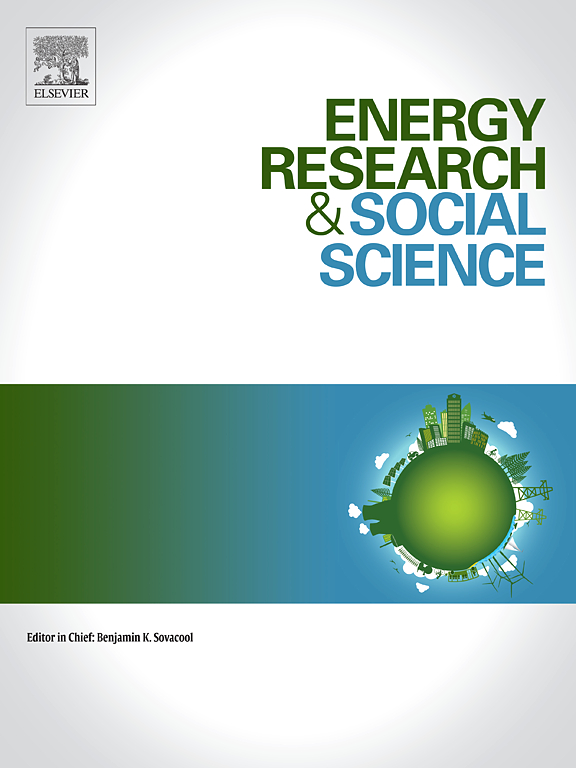沙漠还是花园?能源牺牲区、领土负担和后煤炭景观的竞争愿景:捷克斯洛伐克陆军矿山的案例
IF 6.9
2区 经济学
Q1 ENVIRONMENTAL STUDIES
引用次数: 0
摘要
人们常常用抽象和空洞的术语来讨论摆脱煤炭的过渡。本文旨在展示煤炭开采后的转型如何成为一个地域嵌入的过程,并受到地方行动者的质疑。我们以捷克共和国西北部的捷克斯洛伐克陆军矿山为例,对当地历史(作为能源牺牲区)和领土特征(景观、水和能源)在后煤炭转型中的作用提出了问题。论点是,这种转变是由特定的领土能力,由当地行为者投资于这些能力的期望以及由外部引起的变化所决定的。所有这些相互作用并在地方层面产生问题。我们使用15个访谈和与CSA煤矿相关的文献资料来充实这些论点,这些资料都是在2023年和2024年收集和分析的。调查结果是根据CSA矿的主要开发阶段构成的,首先是作为能源牺牲区,其次是与当前相互冲突的采矿后计划有关。这些问题包括采矿后的湖泊、采矿后空间的宜居性和可用性以及能源生产未来的问题。在所有这些有争议的计划中,我们强调了当地利益相关者的立场,以及他们对社会经济和环境正义的呼吁。本文章由计算机程序翻译,如有差异,请以英文原文为准。
Desert or garden? Energy sacrifice zones, territorial affordances and competing visions for post-coal landscapes: The case of the Czechoslovak Army Mine
The transition away from coal has often been discussed in abstract and disembodied terms. This paper aims to show how the post coal-mining transition is a territorially embedded process that is contested by local actors. We use the case of the Czechoslovak Army Mine in the northwestern part of the Czech Republic to problematize the role of local history (as an energy sacrifice zone) and of the features of territory (landscape, water and energy) in the post-coal transition. The argument is that this transition is shaped by specific territorial affordances, by the expectations that local actors invest in these affordances and by the changes induced from outside. All of these interact and create problematic outcomes at the local level. We flesh out these arguments using fifteen interviews and documentary material related to the CSA mine, all collected and analysed in 2023 and 2024. The findings are structured by the main development phases of the CSA mine, first as an energy sacrifice zone and second in relation to the current conflicting post-mining plans. These include post-mining lake(s), the liveability and usability of the post-mining space and the question of energy production futures. Across all these disputed plans we highlight the positions of local stakeholders and their calls for socio-economic and environmental justice.
求助全文
通过发布文献求助,成功后即可免费获取论文全文。
去求助
来源期刊

Energy Research & Social Science
ENVIRONMENTAL STUDIES-
CiteScore
14.00
自引率
16.40%
发文量
441
审稿时长
55 days
期刊介绍:
Energy Research & Social Science (ERSS) is a peer-reviewed international journal that publishes original research and review articles examining the relationship between energy systems and society. ERSS covers a range of topics revolving around the intersection of energy technologies, fuels, and resources on one side and social processes and influences - including communities of energy users, people affected by energy production, social institutions, customs, traditions, behaviors, and policies - on the other. Put another way, ERSS investigates the social system surrounding energy technology and hardware. ERSS is relevant for energy practitioners, researchers interested in the social aspects of energy production or use, and policymakers.
Energy Research & Social Science (ERSS) provides an interdisciplinary forum to discuss how social and technical issues related to energy production and consumption interact. Energy production, distribution, and consumption all have both technical and human components, and the latter involves the human causes and consequences of energy-related activities and processes as well as social structures that shape how people interact with energy systems. Energy analysis, therefore, needs to look beyond the dimensions of technology and economics to include these social and human elements.
 求助内容:
求助内容: 应助结果提醒方式:
应助结果提醒方式:


